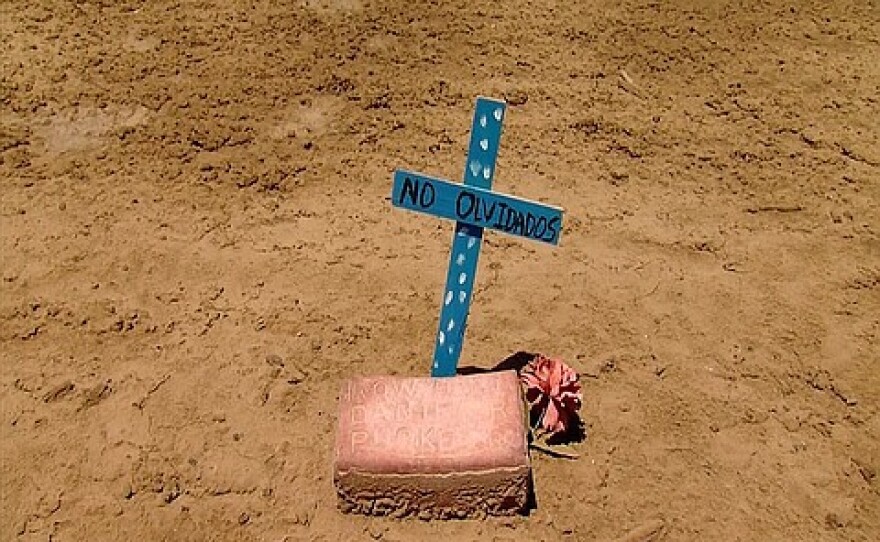The mountainous desert terrain along the U.S.-Mexico border would make building a 2,000-mile wall between the two countries “very, very difficult,” said U.S. Customs and Border Protection Commissioner Gil Kerlikowske in an exclusive interview on Thursday with KPBS.
Republican presidential candidate Donald Trump proposed addressing illegal immigration through the construction of such a wall. But Kerlikowske said it’s costly enough to maintain the current 600 miles of fencing.
“Whenever I’ve been asked about a wall, I’ve always tried to talk about it not from what a particular candidate said, because other people have talked about walls and fences also,” Kerlikowske said. “But anyone who’s familiar with the Southwest border and looks at the range of mountains, rivers, desert, would clearly see that an attempt to build a wall would be very, very difficult, incredibly expensive.”
'The potential for corruption is there'
Kerlikowske also said the agency will attempt to address internal corruption by doubling its number of internal affairs criminal investigators over the next two to three years.
"Certainly, the vulnerability for corruption and the potential for corruption is there," he said.
Earlier this week, a panel of law enforcement experts, including a former Drug Enforcement Administration chief, published a report saying Customs and Border Protection is vulnerable to a “major scandal” because of its failure to double its number of internal corruption investigators, from 200 to 400, as previously recommended by the panel.
Kerlikowske acknowledged that the agency is vulnerable to corruption because of its size — with 60,000 employees, it’s the largest law enforcement agency in the country.
“There’s a lot of building to do, and we’re very intent on meeting a goal of being up to at least 400 personnel, but it will take us a little while to get there,” he said.
It will take two to three years because of the need to obtain funding and approval from Congress, he said.
Body-worn cameras may be in agency's future
Immigrant rights groups in San Diego and other border cities accuse Customs and Border Protection of doing too little to address excessive use-of-force complaints. Kerlikowske disagrees.
“I think the excessive use-of-force complaints are being adequately addressed right now,” he said. “We have a method for recording the complaints, we have a method for making sure they’re being followed up, and ... they have reduced the average length of investigation from what was up to a year down to about 60 days.”
Last year, the agency decided against requiring body-worn cameras for all officers for the time being. When asked if full-scale deployment of the technology is in the agency’s future, Kerlikowske said the cameras would have to evolve first.
“You’re going to have to find a camera that will hold up longer than 90 days,” he said. “I think we’ll receive some support from manufacturers and others, given the size of that workforce, that would be very interested in developing a camera. But the things we’ve tested most recently, given the terrain and where the agents work, have not held up.”
San Diego-Tijuana region offers 'some lessons'
Kerlikowske praised the level of cross-border collaboration among public and private sectors in San Diego and Tijuana, including a bi-national cargo inspection facility in Otay Mesa.
“I think people have worked very hard on both sides of the border to improve and to have those relationships, and I’m sure some other parts of the border could see some lessons learned,” he said.
An increase in Mexican customs inspections of southbound pedestrians through San Ysidro is helping security in both countries, Kerlikowske said.
“We know it’s important that we do everything we can to keep currency and guns from going south, and the better they do inspections of vehicular and pedestrian traffic going south, that just shows that we’re working well together,” he said.
Kerlikowske also discussed a recent surge in arrivals from Central America. He said it hasn’t reached the record levels of 2014 in part because of Mexico’s strategy of boosting the security of its southern border.
But increased border security isn’t the only way to address the flow of migrants from countries like Guatemala, Honduras and El Salvador, he said.
“Improving safety, security, economy and education levels in those countries would be absolutely as important as any additional border security, because people would not be interested in leaving their families to make a dangerous trek to the United States,” he said.
'We're kind of in this together'
Kerlikowske said Mexico’s improved economic performance means fewer people from that country will be setting their sights on the United States.
“If the border with the U.S. is in fact more secure, and it clearly is by every measure, then people will be staying in greater numbers in Mexico,” he said. “We’re kind of in this together.”
When asked about the Mexican government’s attempts to deal with massive quantities of deported migrants in border cities like Tijuana, as well as issues tied to their relocation such as homelessness and drug addiction, Kerlikowske called for increased collaboration between the two countries.
“I know they work very hard at this, and if we can help and exchange additional information … we should be a partner in that also,” Kerlikowske said, citing as a potential example a collaborative effort to determine the latest and most efficient drug treatment methods.







